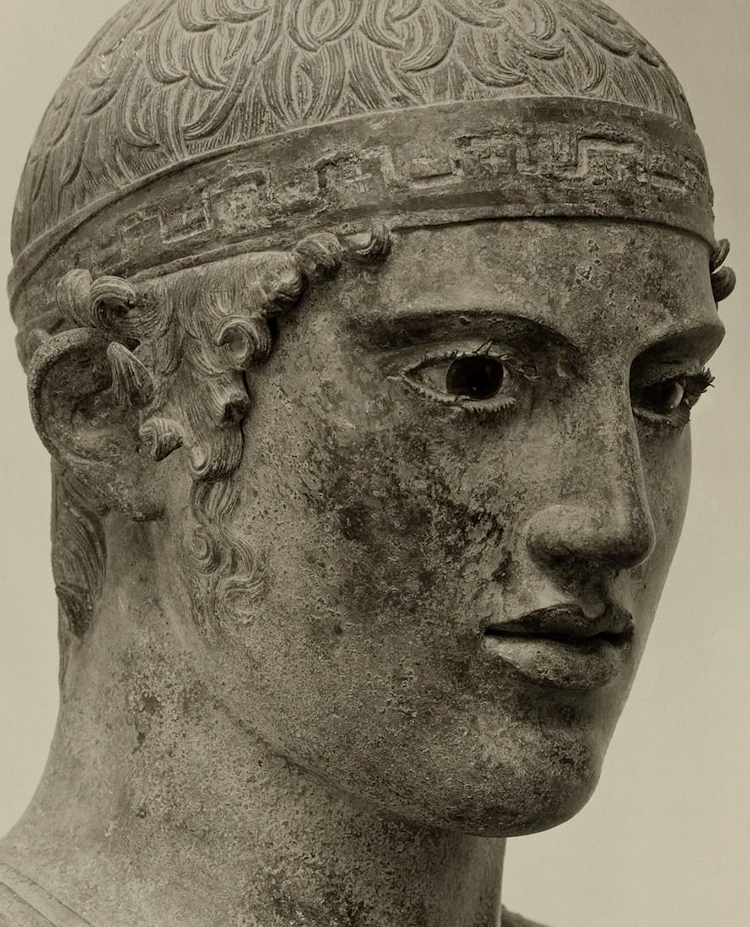Remarkably intact in spite of that, it is only missing its left arm and some of the copper and silver inlays on the face and headband. It's also one of the rare Greek bronzes that has preserved its inlaid glass eyes. Greek bronzes of the time were cast in sections and then assembled. When discovered, the statue had separated into three pieces: the head and upper torso, the lower torso down to the feet, and the right arm.
The figure is of a very young man. Like modern jockeys, chariot racers were chosen for their lightness, but they also needed to be tall, so were frequently teenagers. His full-length tunic has caused scholarly disagreement among those who've studied the piece. Some believe that the elegant figure represents a young man from a noble family; in the Panhellenic Games chariot racers selected their drivers from aristocratic families. But, citing the fact that Greek athletes nearly always competed and were depicted nude, others have speculated that he may have been modeled on a household slave, an individual whom, apparently, it would have been inappropriate to depict unclothed.
Some ten years after the figure's discovery, the Spanish-born, Venetian-resident artist and designer Mariano Fortuny y Madrazo first created a finely pleated silk dress that was said to be inspired by and named after the statue. His Delphos gown, which was produced for several decades and is widely collected to this day, has come to be seen as an important work of art in its own right. Read - and see - much more about the Delphos here:
*
From the Getty Museum website:
Trained as both an art historian and a photographer, Clarence Kennedy cautioned that "the photographer dare not allow himself to use the sculpture for spectacular effects of his own invention....He is not creating something of his own." He began to experiment with lighting and photographing sculpture while a student at the American School in Athens. Returning to the United States, in 1916 he took a position teaching art history at Smith College, where he remained for forty-four years. During this time Kennedy taught photography and made photographs, producing eight volumes of The History and Criticism of Sculpture to be used as teaching aids in his classes at Smith.
Beginning around 1930, Kennedy began a longtime friendship with Edwin Land, with whom he developed the Polaroid instant print process. In the late thirties Kennedy moved away from photography as he became interested in typography, founding the Cantina Press, which he ran out of his home. After assisting in the American Commission for the Protection and Salvage of Artistic and Historic Monuments in the War Area during World War II, he returned to photography, making landscape images in the 1950s.
Trained as both an art historian and a photographer, Clarence Kennedy cautioned that "the photographer dare not allow himself to use the sculpture for spectacular effects of his own invention....He is not creating something of his own." He began to experiment with lighting and photographing sculpture while a student at the American School in Athens. Returning to the United States, in 1916 he took a position teaching art history at Smith College, where he remained for forty-four years. During this time Kennedy taught photography and made photographs, producing eight volumes of The History and Criticism of Sculpture to be used as teaching aids in his classes at Smith.
Beginning around 1930, Kennedy began a longtime friendship with Edwin Land, with whom he developed the Polaroid instant print process. In the late thirties Kennedy moved away from photography as he became interested in typography, founding the Cantina Press, which he ran out of his home. After assisting in the American Commission for the Protection and Salvage of Artistic and Historic Monuments in the War Area during World War II, he returned to photography, making landscape images in the 1950s.









No comments:
Post a Comment